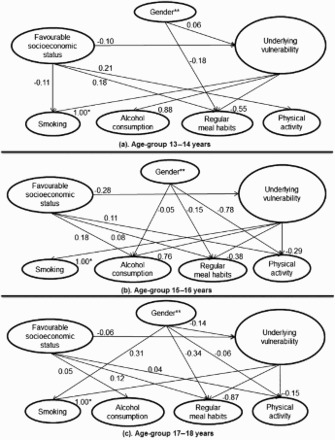Figure 2.

(a–c) Path coefficients of direct associations between a first-order and a second-order latent variable in three age groups.Notes: The path models (a–c) are SEM analyses (of different age groups) of the hypothesised model shown in Figure 1. To simplify the presentation, the indirect and total associations between the latent variables are omitted here, though they appear in Table 4. It should be noted that since the study is cross-sectional, the direction of causality is unknown. Associations are significant at the 95% CI. The small ovals represent first-order latent variables and the large ovals represent second-order latent variables. The second-order latent variable was interpreted as an underlying vulnerability to both health-damaging behaviours and non-participation in health-enhancing behaviours in all age groups.*To standardise the second-order latent variable, the path coefficient to the first-order latent variable ‘smoking’ was fixed at 1.00.**Females vs. males.
